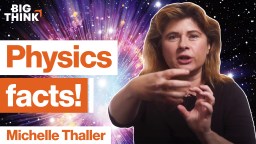MICHELLE THALLER: This July we're going to be celebrating the 50th anniversary of the Moon landing Apollo 11. I was actually not alive for the moon landing. And I have no memory of people being on the Moon. I was alive in the very early '70s, but as a two or three-year-old, was never something that I was aware of. So I never had the chance to look up in the sky at the Moon and think there are people up there today. So in the 1960s, of course, this was a part of the Cold War. It was some of our competition with the Soviet Union. We wanted to make sure that we were ahead of them in terms of building big rockets and missiles and that kind of thing. But I think what's happened now is that we have a much stronger scientific case for returning to the Moon.
And this is something that I'm really excited about as a scientist, not just as an American, and not just as a human. I'm also very much looking forward to having the first woman on the moon, the first person of color on the moon, I think that's very important because so far, everybody who's walked on the moon is somebody that doesn't look a whole lot like me. And I would like that to change in the very near future. But why do I want to go back to the Moon? I mean, we were there before, 50 years ago.
We brought back hundreds of pounds of rocks. So why would you want to go back? And one of the things is that the samples that we took from the moon the rocks, the dust, the soil, from the moon that we took completely revolutionized our view of how the Earth formed, how the solar system formed, and even things that we see as we look out into other solar systems around other stars. Now, why? Well, what changed so much? The moon rocks were entirely different than what we expected. Specifically, anything that could possibly burn at all. What we call volatiles was gone. They were very, very dry. There was almost no water, and by water, I mean water that was actually dissolved into the minerals. I mean not liquid water, not even ice, but water that's contained in the chemical structure of the rock.
But in other ways they were almost identical to the Earth. They had the same type of isotopic ratios, chemical markers about how old the rocks were. And so how could you have something that has such a similar composition to the Earth but be so different? Almost as if you had Earth rocks, but then everything that could possibly burn was taken away. And we realized that the moon must really be something special. It seems that the moon is the product of a giant collision, a collision between planets. Something at least the size of Mars and maybe even bigger, maybe the size of the Earth today, actually hit the young Earth when it was forming. This would have happened billions of years ago.
And debris was thrown off during that explosion that eventually came together under the force of gravity and formed the moon. So in the moon rocks there's records of this giant collision. There may even be records in some of the minerals of what that other planet was like, the planet that's no longer there, what actually hit us to form the current Earth and Moon system. There's also all kinds of wonderful records on the Moon as to what happened to the Earth over time. Unlike the surface of the Earth, the moon doesn't really change much. I mean, yes, there are meteorites that hit it from time to time, but there's no water, no erosion, no wind, there's no chemical weathering of the rocks.
So what you have is a preservation of what the Earth has been through for the last billion, hundreds of millions of years. One of the amazing things we found in moon rocks is evidence that the Earth probably passed very close to an exploding star about 300 million years ago. And there actually was kind of a radioactive rain that came down on us from this exploding star. And we only see that record on the surface of the moon in the rocks, and also at the very bottom of the Earth's ocean. In sediments that are that ancient, they preserved that time. So the moon is actually going to be able to tell us, when we have more samples, what the whole history of the Earth was like, how the Earth formed, and what happened to the Earth over time. Recently, we actually found the oldest Earth rock that we have on the moon. It was actually in a lunar sample.
We found that there was a little bit of Earth that had actually probably been thrown off during a collision. A big asteroid hit us. Rocks flew up into space, some of them landed on the moon. And now, we actually have a sample of the Earth three billion years ago when it was hit by something very large. The moon rocks are also telling us things like where organic molecules, the building blocks of our chemistry, came from, and maybe even the origin of water. We're finding tiny little bits were actually formed during collisions and volcanism on the surface of the moon. Now, all of these things are things we've just realized are there in the lunar samples. Most of the samples have already been picked over and chemically analyzed.
We've crushed things up. We've changed them. We're so much better now at being able to do the chemical analysis, And we understand so much more about what it's saying, That we need better samples. and the exploration is going to be really amazing. One of the challenges is protecting the astronauts from solar storms. We realize we got pretty lucky with Apollo. Had there been a very strong solar storm, It could have damaged instruments, could even have hurt the astronauts. And so now, we know we need to protect people when they're up there. And we'll probably have them land very near craters at the poles of the moon. The poles are really important because there are craters up there that never see sunlight. They're actually permanently shadowed from the sun. And so, if there's a big solar storm, all the astronauts need to do is go down one of these craters, And they can be safe from that.
Also, when you're near the poles. You're almost continuously illuminated by the sunlight, and you have great contact with Earth as well. So I think probably the first place we're going to go, we actually have chosen the South Pole. That's the goal for the place to send astronauts next, South Pole of the moon. So as a scientist, the moon has a much larger context as well. We see things happening in other solar systems around other stars. Occasionally, you see a giant flash of heat, And a solar system many light-years away appears to be full of molten metal All at once. And probably what we've seen is an event like the formation of the moon two planets have collided. I don't know if we'd really understand what was going on if we didn't have the example of the moon right there in front of us.
So it's been more than 50 years, I am really looking forward to someday looking up there, and I really hope I can see a little light, You know something up there at the very base of the moon that you can actually see that there are people up there today. And I think that will be an amazing feeling to look up and feel humanity on the moon again.






